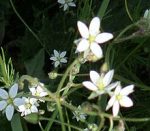
Corn spurry is an annual weed and member of the pink family, Caryophyllaceae, that also includes carnations, baby’s breath, and chickweed. It is native to Eurasia but was introduced into Michigan In 1888 as a forage crop for poor sandy soil and now occurs in much of the eastern part of the country as well as the Pacific Coast. Plants only become established on disturbed sites such as cultivated fields, gardens, open slopes, sand dunes, railroad right of ways. and roadsides.
Description: Plants have a tap root and one or many stems that grow six to eighteen inches tall and may be erect or prostrate. The bright green stems are branched at the base, covered with fine hairs, and are sticky. They carry whorls of six to thirty fleshy thread-like leaves that are 1/2-1 inch long. Loose terminal clusters of white flowers with five petals appear from early spring to mid fall and give way to round seed capsules containing numerous flattened dull black seeds. A single plant can produce up too 7,500 seeds but the seeds do not remain viable in the soil for long. Plants spread by seed.
Control: Mulch to discourage the emergence of seedlings. Pull or hoe seedlings as they appear. Pull, cut, or mow large plants before they set seed. The combination of herbicides chlorsulfuron + 2,4-D has been effective in controlling corn spurry in severe cases.